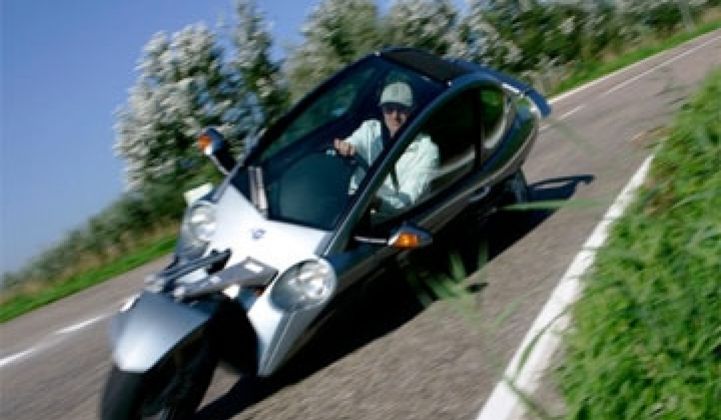Remember the VentureOne, the three-wheeled tilting electric car that was going to combine the eco-sensitivity of a Nissan Leaf and the fun of a Honda street bike, from Venture Vehicles?
The prototype was a hoot to drive. Unfortunately, the price of seats got in the way.
Venture tried to raise money in mid-2008 with the goal of releasing cars to the market in 2010, said Robert Koch, a partner at NGEN Partners and one of the lead investors, during a hallway meeting during the Agrion Business Network for Energy Conference in Palo Alto Wednesday. When the credit crisis hit, however, it became nearly impossible to get money.
At the same time, the collapse of the auto industry threw the component supply chain into disarray. Suppliers simply stopped producing parts for small manufacturers. Instead of being able to get a driver's seat off-the-shelf, it became a custom order.
"The BOM (bill of materials) ballooned," he said. "That was a very big issue."
Koch also admitted that his firm vastly underestimated the cost of getting a car company off the ground. The firm initially thought it might take $20 to $30 million to get to the early production level. The real price was likely closer to $100 million, a no-go price in an economic crunch. Well, at least NGEN wasn't the first to do that.
The founders of the company have since taken back the intellectual property, renamed the company Versu, and are trying to make a go of it.
Meanwhile, Tom Gage, arguably the godfather of the modern electric car, sees a future in China.
AC Propulsion, which designs drivetrains and technology for electric cars, is working with a variety of Chinese auto makers, said Gage, the CEO of AC, during a presentation at the conference.
It's an interesting development. Founded in 1992, AC Propulsion and its executives have been involved in a large number of the electric vehicle projects in the U.S. over the last two decades. Gage himself worked at Chrysler while other execs participated on the fated EV1 project at General Motors. Gage also helped introduce Martin Eberhard to Elon Musk after both independently approached Gage with the idea of mass producing electric sports cars. Gage declined, but Eberhard and Musk went on to found Tesla Motors and write one of Silicon Valley's most enduring love stories.
China has already signaled that it wants to own a large part of the EV market; 13 separate EV trials are underway in China. Two companies -- BYD and Coda Automotive -- hope to produce cars in China and sell them in the U.S.
Chinese companies in general need to work on the quality of their automotive engineering to go international, Gage said. Car makers also need to reduce the cost of batteries for wider commercial proliferation. The relatively slow turnover in the automotive base additionally means that electrics will be unlikely to constitute a majority of the car base for years. Even if 30 percent of the cars sold in 2030 are EVs, that will likely mean that only eight percent of the cars are on the road are electric, he said. Grid issues must be worked out as well.
Still, if the price is the same, consumers will gravitate toward electric cars over gas cars in most circumstances because of the performance advantages and other features, he said.
Finally, Cobalt Technologies -- which opened a prototype plant earlier this year -- says it has concocted a formula to produce biobutanol out of lodge pole pine decimated by beetles. The beetle infestation is caused, many believe, by global warming, so it's a real lemons-to-lemonade story.
"With this breakthrough, we've been able to turn a problem into an opportunity," said CEO Rick Wilson in a prepared statement. "If we use only half of the 2.3 million acres currently affected in Colorado alone, we could produce over two billion gallons of biobutanol -- enough to blend into all the gasoline used in Colorado for six years."
Cobalt's goal is to be able to produce fuel for around $1.40 a gallon (as well as green chemicals) in a million-gallons-a-year plant in 2012. The company uses a combination of chemical and biological processing.
First, the company cooks wood chips and forest waste with chemical catalysts. The mash is then inserted into a vat filled with bacteria, which ferment it into biobutanol in a relatively small container. The one in the pilot plant we saw earlier this year is about 15 feet high and has a three-foot circumference (see video). The fermentation process is quite concentrated, which cuts down on the amount of steel and equipment needed to turn sugar into fuel.
"In concentrating the bacteria, we've shrunk the fermentation process ten times," he said back in January.



